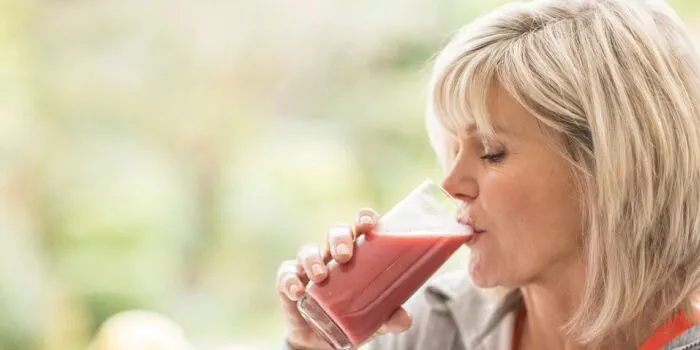Symptoms of menopause – how to help hot flushes
As part of the menopause, women produce less oestrogen. This drop in oestrogen levels not only stops your periods but can also cause some unpleasant side-effects, which includes hot flushes. Here I’ll discuss how to handle this common menopause symptom, so you can enjoy life again.

What do hot flushes feel like?
If you’re having a hot flush, you may experience:
- a sudden feeling of heat spreading through your body
- a red flush spreading across your chest, neck, face and head
- sweating
- heart palpitations
- feelings of anxiety
- a lack of concentration
How long do hot flushes last?
A hot flush can occur at any time of the day, and usually lasts several minutes, but the average is around four minutes. You may have them a couple of times a week or up to every hour. Hot flushes that happen at night are known as night sweats. You may carry on getting them for several years after your periods stop.
How can you deal with hot flushes?
There are some things you can do to help manage hot flushes yourself. Try these tips to stay cool, calm, and collected.
Avoid triggers
Although hot flushes can be unpredictable, you might find they’re worse after drinking alcohol or caffeine, after eating spicy food or when you’re stressed, for example. Try keeping a diary for a few weeks to see whether you notice a link or trigger.
Dress lightly
Wearing lighter clothing made of natural, breathable fabrics, such as cotton, silk or soft wool, might help you to keep cool. Go for looser styles rather than tighter ones. During the colder months, wear a few light layers so you can easily take some off when you feel a hot flush coming on.
Layer your bed linen
Try to keep your room cool. Rather than using one heavy duvet, try layering a few light blankets and sheets made from natural fabrics. Sheets made of 100 per cent cotton are usually cool and comfortable.
Use a fan
Keep a fan in your bedroom and on your desk for times when you need to cool down. You can also carry a battery-powered mini-fan in your bag or go for use a traditional hand-held fan.
Carry a cooling spray
Keep a small spray bottle in your bag, on your desk or near to hand when you’re at home. Fill it with water and give yourself a little spritz to cool down during a hot flush.
Take a lukewarm shower
When you take a shower, aim for a temperature that’s medium warm rather than hot.
Lead a healthy lifestyle
Following a healthy lifestyle can help not only with hot flushes, but with many other symptoms of menopause. Eat a healthy diet, exercise regularly, drink sensibly and don’t smoke. This will also help to reduce your risk of developing things like heart disease and osteoporosis, as the risk of these is higher after menopause.
Is there a treatment for hot flushes?
How severe and how frequent your hot flushes are will be different for every woman. If you’re finding it difficult to manage your hot flushes with the tips above, there are other interventions you may be able to try.
Supplements and complementary therapies
Some women try supplements and complementary or alternative remedies to ease their menopause symptoms. It’s important to note that supplements come in many different preparations and their quality, purity and safety varies. There is some evidence that a few might have a benefit, but for others, the science is still unclear.
Some women claim that acupuncture or relaxation techniques help them with menopausal symptoms, but there is little evidence to support their use. Speak to your GP before trying a supplement or remedy as some can interact with other medications you might be taking.
HRT and other medications
Your GP can also talk to you about hormone replacement therapy (HRT), which replaces oestrogen. It’s the most effective treatment for hot flushes. Your GP will explain the risks and benefits of taking HRT.
For some women who decide not to take HRT, or if it’s not recommended for you, there are other non-hormonal medications available. If hot flushes are affecting your day-to-day life, don’t suffer in silence – talk to your GP about what might work for you.
If you’re experiencing menopause symptoms, you don’t have to face them alone. With a Bupa Menopause Plan, you can discuss symptoms with a specially trained GP, get a personalised care plan based around your needs with access to 24/7 support via Anytime HealthLine.
-
Sources Sources
- Hot flushes. Patient plus. Patient.info/doctor, last reviewed January 2025
- Menopausal symptoms: In Depth. National center for complementary and integrative health (NCCIH). Nccih.nih.gov, accessed June 2025
- Treatment for the symptoms of menopause. Royal College of Obstetricians and Gynaecologists. Rcog.co.uk, accessed June 2025
About our health information
At Bupa we produce a wealth of free health information for you and your family. This is because we believe that trustworthy information is essential in helping you make better decisions about your health and wellbeing.
Our information has been awarded the PIF TICK for trustworthy health information. It also follows the principles of the The Information Standard.

More general health advice articles
Bupa menopause plan
Not sure if you're going through the menopause? Need help dealing with symptoms? Talk to a specially trained Bupa doctor and get a personalised plan.
Bupa menopause plan
Did you find our advice helpful?
We’d love to hear what you think. Our short survey takes just a few minutes to complete and helps us to keep improving our healthy lifestyle articles.
Legal disclaimer
This information was published by Bupa's Health Content Team and is based on reputable sources of medical evidence. It has been reviewed by appropriate medical or clinical professionals and deemed accurate on the date of review. Photos are only for illustrative purposes and do not reflect every presentation of a condition.
Any information about a treatment or procedure is generic, and does not necessarily describe that treatment or procedure as delivered by Bupa or its associated providers.
The information contained on this page and in any third party websites referred to on this page is not intended nor implied to be a substitute for professional medical advice nor is it intended to be for medical diagnosis or treatment. Third party websites are not owned or controlled by Bupa and any individual may be able to access and post messages on them. Bupa is not responsible for the content or availability of these third party websites. We do not accept advertising on this page.







